This is a Pentina M, a 35mm Single Lens Reflex camera originally made by VEB Kamera-Und Kinowerke Dresden, and then later by VEB Pentacon Dresden between the years 1963 and 1965. The Pentina was a very unique looking camera with shutter priority automatic exposure, a selenium cell exposure meter, a central leaf shutter, and a sleek body that completely hid the angular pentaprism normally found on the top of typical SLRs of the day. The camera had it’s own unique bayonet lens mount and supported a couple lenses that were produced for it. A combination of an unorthodox left handled control layout, a lens mount that was incompatible with anything else out there, and an over saturation in the market caused the Pentina to only be produced for about 4 years before it was discontinued making it a rather uncommon camera today.
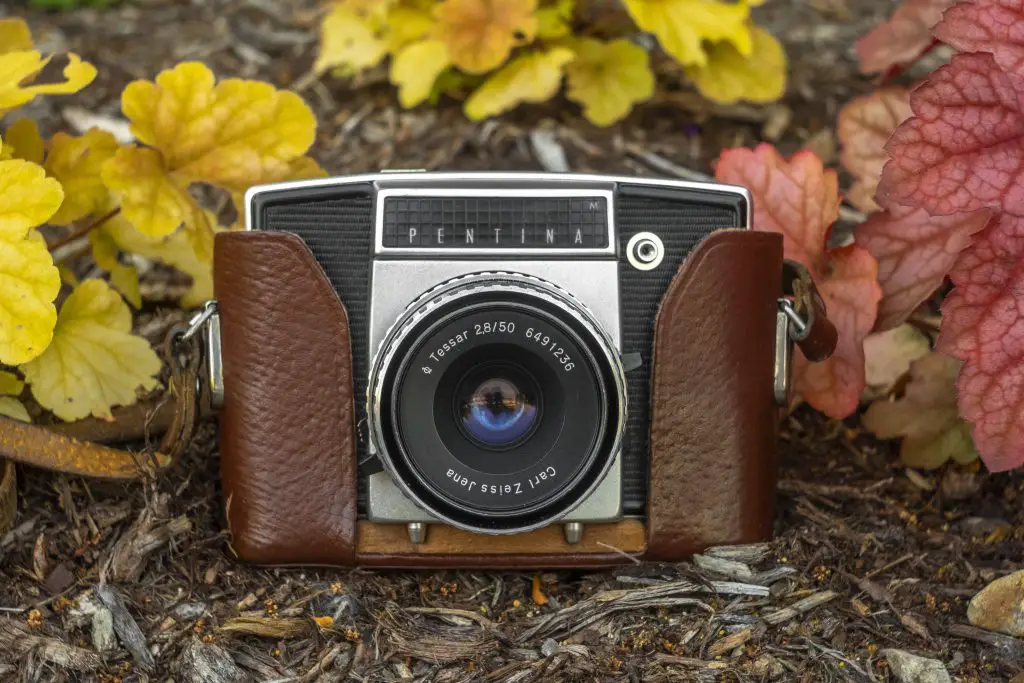 Film Type: 135 (35mm)
Film Type: 135 (35mm)
Lens: 50mm f/2.8 Carl Zeiss Jena Tessar coated 4-elements
Lens Mount: Pentina Breech Lock Bayonet
Focus: 1.6 feet to Infinity
Viewfinder: Fixed SLR Pentaprism
Shutter: Prestor MXV Leaf Shutter
Speeds: B, 1 – 1/500 seconds
Exposure Meter: Coupled Selenium Cell with Shutter Priority Automatic Exposure
Battery: None
Flash Mount: Coldshoe and M and X Flash Sync
Weight: 811 grams (w/ lens), 694 grams (body only)
Manual (in German): https://www.cameramanuals.org/pdf_files/pentacon_pentina.pdf
Manual (transcribed in English): http://web.archive.org/web/20120320080406/http://www.marriottcameras.co.uk/instruct3/pentina/with_pictures.htm
How these ratings work |
The Pentina is an interesting camera to use. It is an attractive and easy to use camera, once you get over the left handed controls and SLR viewfinder in a body that looks nothing like an SLR. The standard 50mm Zeiss Tessar lens is an excellent performer, but this camera’s poor reputation for reliability makes it difficult to find one in good working order. The one I used for this review had a couple issues that I had hoped I could work through, but it broke midway through it’s first roll. Had this camera been in better working condition, it could have been a favorite of mine to come back to. Recommended as a shelf queen, but nothing more. | ||||||
| Images | Handling | Features | Viewfinder | Feel & Beauty | History | Age | |
| 2 | 1 | 1 | 2 | 2 | 1 | 20% | |
| Bonus | none | ||||||
| Final Score | 10.8 | ||||||
The story of the Pentina is quite confusing and what little information I have found is quite vague as there’s very little info on the web about it’s origins. Most of the info I did find is usually in German and I don’t know if it’s a result of an inaccurate German to English translation or if just no one knows, but exactly who designed the camera is a bit vague too. Perhaps the biggest mystery of the Pentina is the so called “1st Generation” of cameras that were supposedly made between 1961 to 1963 which none seem to exist.
While researching this article, I reached out to Rudolf Hillebrand, who for the past 25+ years has published an excellent German language magazine called Photo Deal, and while Rudi did provide me with some helpful clues, he also shared my frustration with a lack of detailed info, saying:
Our common and repeated problem with all research is that information is scarce, everything is that long ago that most witnesses are under the earth, many documents have gone lost or destroyed in one or even two world wars.
What follows is my best attempt at translating, combining, interpreting, and presenting what I believe to be the most comprehensive history that I can find for this camera. There is a very good chance I get something wrong and if I do, please do not accuse me of writing fiction or making erroneous deductions as I go.
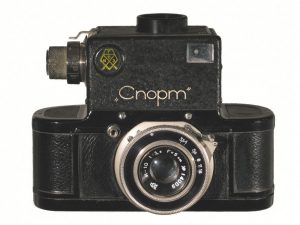
The Single Lens Reflex camera first made it’s debut in the 1930s and at the time of it’s release was a clunky, slow design that didn’t immediately appeal to professional photographers who much preferred rangefinders like the Leica and Contax. The disadvantages of the SLR were many, dark viewfinders, viewfinder blackout during and after exposure, more noise caused by the slow moving mirror, and like all waist level reflex cameras, an inverted viewfinder that caused composed images to be backwards from reality.
As time went on, the SLR improved upon it’s weaknesses with pentaprism viewfinders, instant return mirrors, brighter viewfinders, and quieter operation. Despite these improvements, there was still one area in which existing SLR designs would likely never significantly improve, which was flash synchronization speed. In an SLR camera with a focal plane shutter, flash synchronization can only occur when both shutter curtains are wide open. On most early SLRs, this occurred at a maximum speed of about 1/25 to 1/50. Although the shutters were capable of speeds as fast as 1/1000 and sometimes faster, at anything higher than the flash sync speed, the second curtain would begin closing before the first curtain finished opening which if you fired a flash, would cause part of the exposed image to be blacked out.
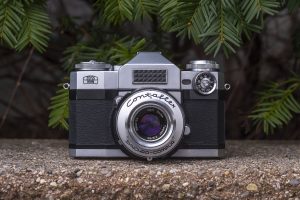
While working for Zeiss-Ikon during World War II, designer Hubert Nerwin had an idea to create an SLR design with a leaf shutter that would eliminate this problem, allowing for flash synchronization to occur at any speed. It wouldn’t be until 1953 that his design for what would become the Contaflex reached the market, but upon it’s release, the Contaflex was the world’s first 35mm SLR camera with a centrally located leaf shutter capable of flash sync speeds up to 1/500, or nearly 10 times faster than that of competing focal plane SLRs.
The Contaflex SLR would be produced in West Germany by Zeiss-Ikon and was an immediate success. Shortly after it’s release, several other West German and eventually Japanese companies would begin working on their own leaf shutter SLRs. AGFA, Braun, Kodak, Voigtländer, Aires, Kowa, Mamiya, Minolta, and even Nikon would eventually put out their own leaf shutter SLR cameras.

For someone not familiar, creating an SLR with a leaf shutter instead of a focal plane shutter might seem like a fairly straightforward task, but that is far from the truth. Although leaf shutters had been in common use by camera makers for decades prior to the Contaflex, the location of the lens in font of the reflex mirror proved to be a major technological hurdle. I’ve explained the differences between leaf shutter SLRs and focal plane shutter SLRs many times before, so if you’d like to learn more, check out my Keppler’s Vault article on them.
By the late 1950s, perhaps due to the complexity of the design, or maybe even an ambivalence by the state run government in East Germany, no East German camera makers had yet created a leaf shutter SLR.
In 1958, while attending the Berlin-Weißensee University of Fine Arts, Jürgen Peters proposed an early design for an all new leaf shutter SLR in his diploma thesis. What role Jürgen Peters had in the design of the Pentina is unclear. Did he just come up with the idea of the shutter, or did he actually build something? Most sites, including Dr. Mike Otto’s praktica-collector.de site state that a man named Hans Daeche was responsible for the camera’s design, but this is somewhat contradicted by an article that appeared in the 2000 / IV issue of Photo Deal magazine called “Pentina – Sein oder Nicht-Design” by Heinz Schrauf who suggest that Jürgen Peters was also responsible for the camera as well.
While talking to Rudi Hillebrand from Photo Deal, I asked him about this and he reached out to his friend, Dieter Riebe who has done extensive research about GDR cameras and was told that Walter Hennig, who helped design the Contax S, was also involved in the Pentina’s design, further complicating the history.
The article below is the original “Pentina – Sein oder Nicht-Design” by Heinz Schrauf, from Photo Deal, presented here with permission from Rudi.
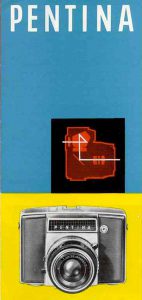
Whoever designed the it, the first signs of a new East German leaf shutter SLR appeared in brochures around 1960 as the Pentina. A so called first generation Pentina appeared in Richard Hummel’s book “SLR Cameras from Dresden” that is said to have gone into production in March 1961 with three separate sub-models, the Pentina I, Pentina II, and Pentina II M.
Strangely, no examples of this first generation Pentina exist on the Internet. According to Heinz Schrauf’s 2000 article in Photo Deal magazine, Jürgen Peters goes on record to say that the second generation Pentinas were the only ones ever produced starting in May 1963.
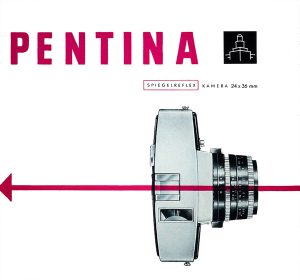
Did a first generation Pentina exist in only prototype form or were they produced in such small numbers that none have ever shown up in circulation? If the second generation Pentinas were the first ones produced starting in May 1963, then why was there such a long delay from the examples showing up in brochures in early 1960?
I doubt we’ll ever really know the answers to these questions because most of the people who would know, likely are no longer alive, and if some definitive resource existed, it should have shown up by now.
Nevertheless, starting with the Pentinas from 1963, we know that four variants exist:
- Pentina – Base model with selenium cell automatic exposure system
- Pentina M – The above model upgraded with a split image focus aide in the viewfinder
- Pentina FM – The above model but also with a Fresnel lens ground glass
- Pentina E – Economy model with no light meter.
All Pentina models would go on sale at the same time in May 1963, except the Pentina E which would make it’s debut in February 1964.
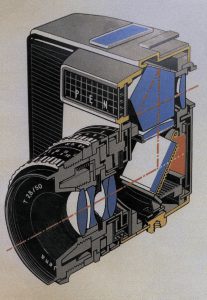
The Pentina was notable not only as the first East German SLR with a leaf shutter, but it also completely ignored all previously established expectations for how a 35mm SLR should look and work. The entire body uses a minimalist design with an almost barren top plate. The viewfinder uses an eye level pentaprism, but you wouldn’t know it looking at the camera as the prism is entirely hidden under the camera’s top plate.
Take a look at the cross section drawing to the right, which shows the light path through the lens, then pentaprism, and out the viewfinder eyepiece.
Another uniqueness of the camera’s design was that essential controls like the film advance lever and shutter release are on the camera’s left side which was unusual for a camera making it’s debut in the 1960s. Other left handed cameras like the Ihagee Exakta and Kodak Ektra both debuted before WWII at a time when the control layout of a 35mm camera wasn’t quite as established.
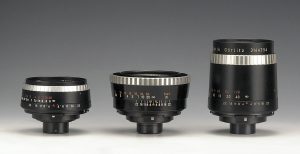
One of the biggest features of the Pentina was it’s automatic exposure system which required special lenses that could be automatically controlled by the camera body’s selenium meter. To make the lens and aperture linkage work, an all new bayonet lens mount was created for the Pentina with a total of four lenses available.
In addition to the standard Zeiss Tessar 50mm f/2.8 lens that came with the camera, there were also a wide angle, short, and medium telephoto lenses available too.
- Meyer Lydith 30mm f/3.5
- Zeiss Cardinar 85mm f/2.8
- Meyer Domigor 135mm f/4
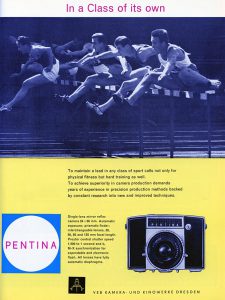
A fifth Domigon 30mm f/3.5 lens was announced in a 1960 brochure for the camera, but was never produced.
A total of 44,187 second generation Pentinas were produced with the most common model being the FM at 10,625. I am unsure about how and where the camera was marketed and sold. The presence of the English language ad to the right suggests it was exported out of Germany, but I found no evidence in any American publications or catalogs suggesting it was sold in the United States.
Guessing at a price is difficult too because of the general opinion Western countries had of products made in East Germany. When products like the Praktica or Soviet made cameras were sold here, they were often considered low end “bargain” cameras, so a relatively upscale GDR made automatic SLR with a unique design and interchangeable lenses might have been a tough sell to American photographers.
The closest comparison I can make to the features of the Pentina would have been Nippon Kogaku’s Nikkorex 35, which in February 1962 sold in the US for $120. The Nikkorex had the benefit of better brand recognition than the Pentina would have, but did not have interchangeable lenses, so my guess is that had the Pentina been sold in the US, it would have retailed probably between $100 – $120, which when adjusted for inflation is comparable to $850 – $1025 today.
Edit (4/29/20): After publishing this review, I finally came across a price that the Pentina might have sold for when imported to the United States.
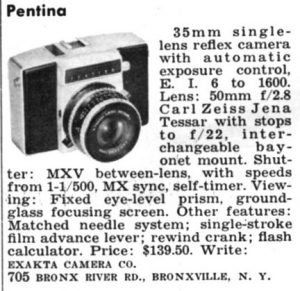 In the “New Products” section of the January 1962 issue of Modern Photography, the Pentina is shown with a price of $139.50 which is higher than my estimation above. The seller is listed as “Exakta Camera Company” of Bronxville, NY. If this price is accurate, it translates to an inflation adjusted price of about $1200, making it more expensive than the Nikkorex.
In the “New Products” section of the January 1962 issue of Modern Photography, the Pentina is shown with a price of $139.50 which is higher than my estimation above. The seller is listed as “Exakta Camera Company” of Bronxville, NY. If this price is accurate, it translates to an inflation adjusted price of about $1200, making it more expensive than the Nikkorex.
Today, the Pentina is hardly collectible. It’s relative obscurity and East German roots are likely big reasons that people don’t seek them out too much which is a shame because this camera has a unique and attractive design that is unlike the many similar cameras that were being released in the 1960s. It’s modern (for the time) feature set including auto exposure, a bright and easy to use pentaprism viewfinder, and standard Zeiss Tessar lens means it should be capable of excellent results.
Edit (8/10/21): Just today, I found what is likely the only review of the Pentina in an English language magazine.
In the January 1962 issue of Modern Photography, Herbert Keppler gave a short one page mini review of the Pentina confirming the $139.50 price listed in the graphic above. In it, it comments on the left handed shutter release and location of the viewfinder saying that this camera might be ideal for lefties, but right eyed photographers might not like it’s location.
Keppler gave the camera mostly positive remarks saying the viewfinder was unusually large and bright for a leaf shutter SLR, that the exposure meter was accurate, and that the results from the interchangeable Tessar lens was good in the center with softness near the edges wide open.
My Thoughts

My reaction the first time I saw a Pentina for the first time, was wow, what a nice looking camera! I figured it was another Zeiss-Ikon scale focus camera produced in the 1960s or so, but didn’t really think much more about it until I learned that this was no simple scale focus camera, but a modern SLR with automatic exposure and interchangeable lenses.
I was immediately enamored with the camera and began my search for one. As I learned more about the camera, I realized it was a leaf shutter reflex design which I have a tumultuous relationship with. Leaf shutter SLRs are some of the coolest, but also least reliable styles of cameras ever made. Models like the Kodak Retina Reflex, Zeiss-Ikon Contaflex, and Kowa SLR series often have issues, many of which render the camera inoperable, and even worse, are very difficult to fix.
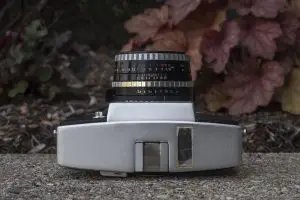
Still, I thought this camera was cool enough that it was worth the risk. The Pentina has a sleek and minimalist design, and nowhere is that more apparent than the top plate which has an accessory shoe, the meter read out, and that’s all. No shutter release, exposure counter, rewind knob, film advance lever, or even a logo. The top is so bare, you would be forgiven for thinking this was some kind of ‘white label’ prototype.
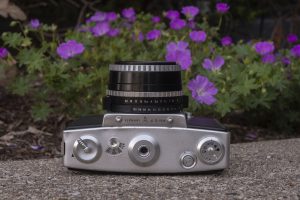
Looking at the bottom of the camera, there is a centrally located 1/4″ tripod socket and rewind button. In addition, we see some of the things that would normally appear on the top of most cameras like the fold out rewind crank, the ASA speed dial for the meter, and a film type reminder disk.
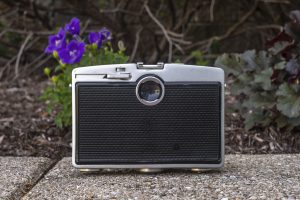
On the camera’s back we find two more features that are normally on the top of most cameras, the exposure counter and the left-handed film advance lever. The viewfinder opening also has some kind of bayonet attachment around it suggesting that some viewfinder accessories like diopters or right angle attachments might have been planned for it.
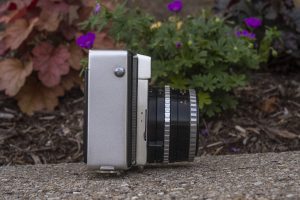
For the first time user of a Pentina, it’s not obvious how to get the back open as the latch needed to unlock it is very small and located in the bottom corner of the camera’s right side. Pull this down and the back comes entirely off the camera. Also on this side of the camera you can see one of the Pentina’s proprietary strap lugs which only works with straps designed for it. On the side of the shutter you can also see the lever for M and X flash synchronization and the setting for the self timer.
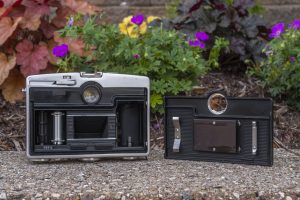
Film transport on the Pentina is opposite of most 35mm cameras of it’s era. Film loads from right to left onto a fixed single slotted take up spool. The spool itself is narrow and located deeply in the crevice next to the metal sprocket shaft. Finding the slot for inserting the leader of a new roll of film is something that requires good lighting to see. People with big stubby fingers might find this to be difficult to do as there’s not a lot of room. The inside of the camera back has a smooth metal film pressure plate and two metal tabs for keeping the film flat while traveling through the camera.
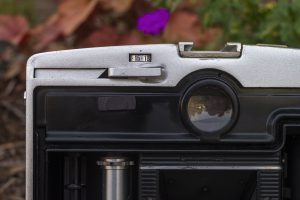
With the camera back still off, you’ll notice a small rectangular tab to the left of the viewfinder and below the film advance lever. This little tab is for resetting the exposure counter. If you forget to reset the exposure counter after re-attaching the back, you must take it off again.
Immediately after installing a new roll of film, slide it left and right to manually rotate the exposure counter. Since you cannot change the exposure counter after attaching the back, in order to get it to ‘0’ for a fresh roll of film, you need to set it to ’38’, then reinstall the back, advance the film and fire the shutter twice to get past the exposed film leader, and only then will the exposure counter be set to ‘0’ for your first exposure.
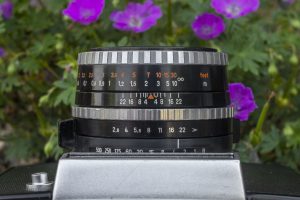
Like most leaf shutter cameras, the shutter controls are all around the perimeter of the lens and shutter, easily read while looking down at the top of the camera.
Closest to the front of the lens is the focus ring, which on the standard Tessar lens allows you to focus as closely as 1.6 feet or just under 0.5 meters. The inner chrome ring is actually the breech lock release for the interchangeable lens mount which I’ll get to later. Behind that are both the aperture and shutter speed selector rings. Both of these rings are controlled by opposing plastic paddles conveniently located on the right and left sides of the shutter, respectively. I quite liked the layout of these controls as you’re most likely going to change focus with the camera to your eye, so putting it farthest out makes it the easiest to locate, and with the relatively thin aperture and shutter speed rings, the side paddles make them very easy to change unlike many other leaf shutter cameras that require you to grip the rings directly.
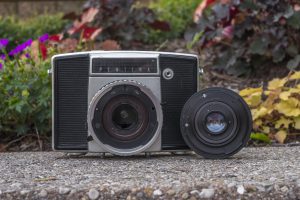
I already spoiled the surprise, but the Pentacon uses a breech lock bayonet lens mount almost identical to Canon’s R/FL/FD mount in which installing and removing the lens requires rotating a metal ring that holds the lens firmly in place. The location of this ring is convenient for when you need to switch lenses, but is in a location where I could see someone accidentally turning it when trying to locate the focus ring. The Pentina’s manual specifically warns you against mistaking this ring for the focus ring.
With the breech lock released, the lens simply lifts off the body, no twisting required. At the 12 o’clock position of the lens mount is a notch that must line up with a small post on the back of the lens to help line it up in the correct orientation when mounting the lens.
Breech lock bayonet lenses eventually fell out of favor with camera designers as many people found them difficult to get on and off, but the supposed benefits of them were that because the lens doesn’t twist against the body of the camera during removal and installation, it won’t ever rub away some of the metal and change the focus distance of the lens. Considering that only 4 lenses were ever made for the Pentina and it had a very short life, I doubt any examples of this camera were ever used enough times for this to become an issue.
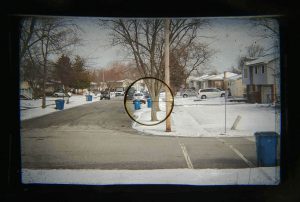
The viewfinder in the Pentina is very East German in it’s brightness and design. Featuring a large and distinct split image focus aide, the viewfinder looks almost identical to those found in Ihagee Exakta or Wirgin Edixa SLRs. The flat ground glass focusing screen is surprisingly bright, both for it’s age the the presence of an f/2.8 lens. I’ve seen cameras with faster lenses have darker viewing screens. Light drop off near the corners is noticeable, especially indoors, but is hardly unusable. I don’t know what the coverage and magnification of the viewfinder is, but I had no problem seeing the entire image while wearing prescription glasses.
The Pentina is a capable camera with all the right features that someone looking for a semi automatic SLR in the 1960s might need. The design of the camera proves that there were still East German camera companies looking to try something new, but ultimately, the camera wasn’t successful enough to stay in production for long. It seems that when it came to building cameras that people would want to buy, the “status quo” was the right choice.
My Results
When I first got the Pentina, it’s shutter was a bit sluggish, but I found that after firing it a few dozen times, it started to loosen up without any additional influence from me. Not wanting to tempt fate, I quickly loaded up a roll of fresh Fuji 200 and took it with me on a fall trip to a family pumpkin farm near where I live.
Using the Pentina is a strange experience. It’s kind of like if you take a sip from a glass that you expect to have iced tea in it, but it’s actually Coca-Cola and the sudden shock of Coca-Cola instead of the tea causes a moment of confusion for your taste buds.
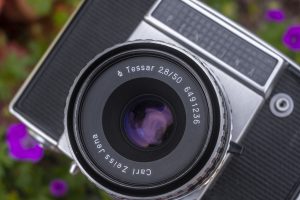
That is kind of what it is like to shoot the Pentina. Even though you know this is an SLR, it neither looks, nor feels like one. From the camera’s minimalist looks, complete lack of a visible pentaprism, and left handed controls, this camera causes brief moments of disorientation each time I brought it to my eye.
I question the decision of putting the shutter release and film advance lever on the left side of the camera. Not that I have anything against left handed cameras, it’s just a curious choice as by the time this camera was released, having things on the right side was pretty much the standard by camera makers everywhere.
With my unique bouts of disorientation out of the way, the Pentina is quite a capable shooter. The viewfinder is nice and bright and the inclusion of the split image focus aide made finding focus in nearly every situation quite simple. The exposure meter on this example didn’t work any more, so I just shot everything using Sunny 16.
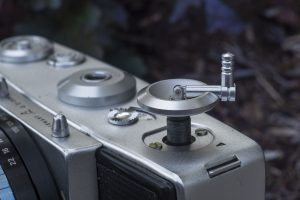
Sadly, before I could finish my first roll, the camera’s initial issues with the sluggish shutter came back and eventually seized up not only the shutter but the film advance. I removed the film from the camera and attempted to flush the shutter, but that didn’t seem to help. Something else was wrong. I did some research online about repairing this camera, but found unanimous information suggesting this is an extremely difficult camera to repair, so I just set it aside and finished the roll in a different camera.
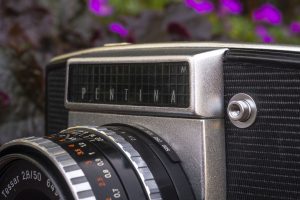
Upon seeing the images I got from it, I also detected a bit of internal haze that I hadn’t noticed when first inspecting the camera. Thankfully the haze didn’t ruin the images and I could still see the familiar sharpness and consistent coverage I’d expect of any Tessar lens. I can’t fault a nearly 60 year old camera for issues with internal haze, a dead meter, or shutter issues, but I feel pretty confident saying that when it was new, the Pentina was quite a capable camera. Whatever reasons that caused the camera to be produced for such a short time likely had nothing to do with it’s performance.
I quite liked the experience of shooting the Pentina and the images I got from it, excepting the haze, were excellent. It’s clear that some thought and effort went into this camera, but I still wonder at the ergonomic decisions. I certainly can’t fault the leaf shutter for failing as most of the ones by Kodak, Zeiss, and Voigtländer have done the same, but I’m not so sure I can recommend this camera to someone looking to use one today. If you like shelf queens, then by all means as there’s nothing else quite like it out there, but just don’t get your hopes too high if you want to shoot one.
Related Posts You Might Enjoy
External Links
http://www.praktica-collector.de/Pentina.htm
https://zeissikonveb.de/start/kameras/pentina-1.html (in German)
https://www.aperturepreview.com/pentacon-pentina-ii
https://www.dresdner-kameras.de/pentina/pentina.html (in German)
http://www.oddcameras.com/pentacon_pentina.htm
https://www.photo.net/discuss/threads/pentina-resurrection-and-life.479247/
https://www.photo.net/discuss/threads/some-praise-for-the-pentina.491807/
https://tinkeringwithcameras.blogspot.com/2017/11/pentina-repair.html

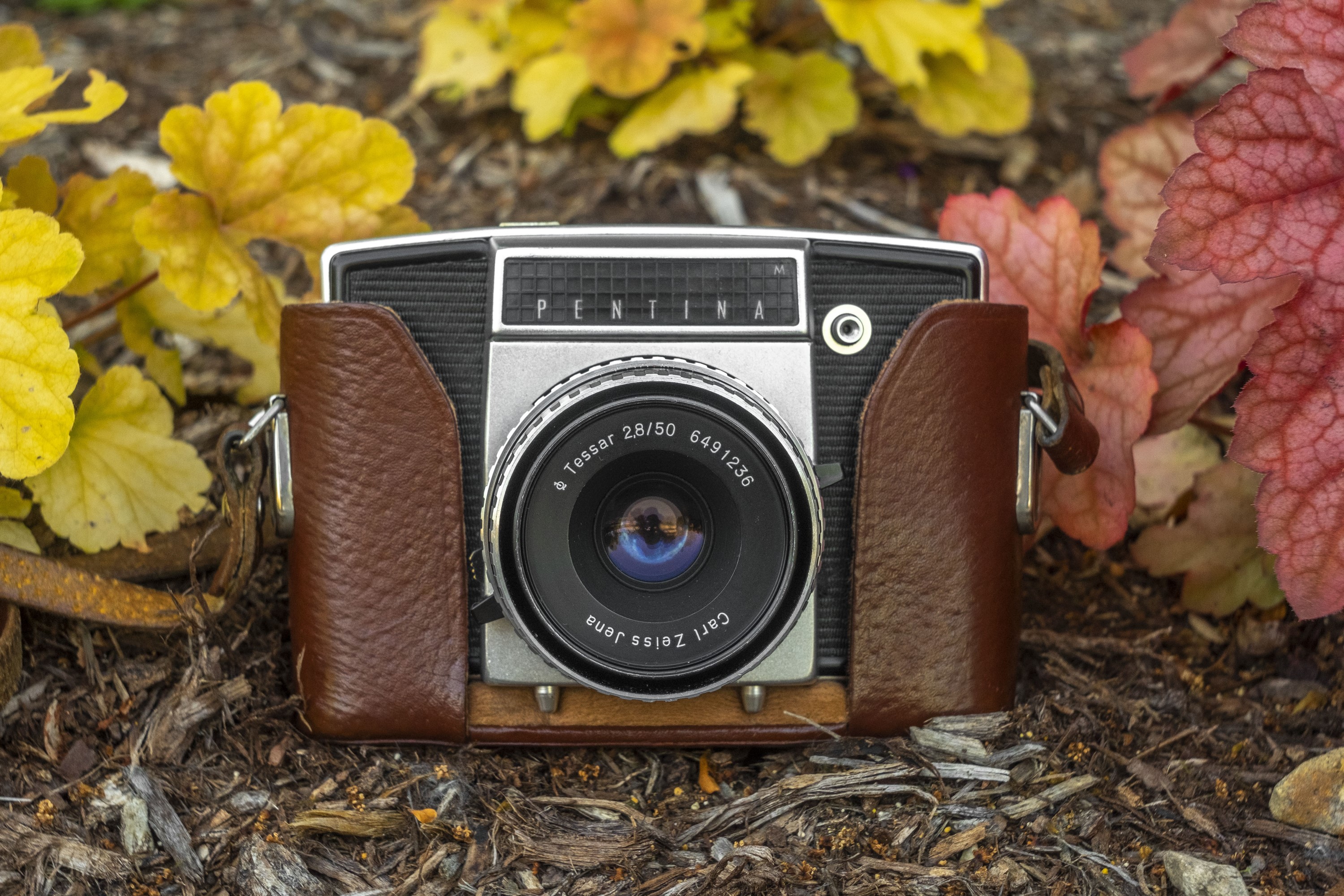
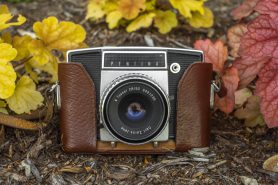

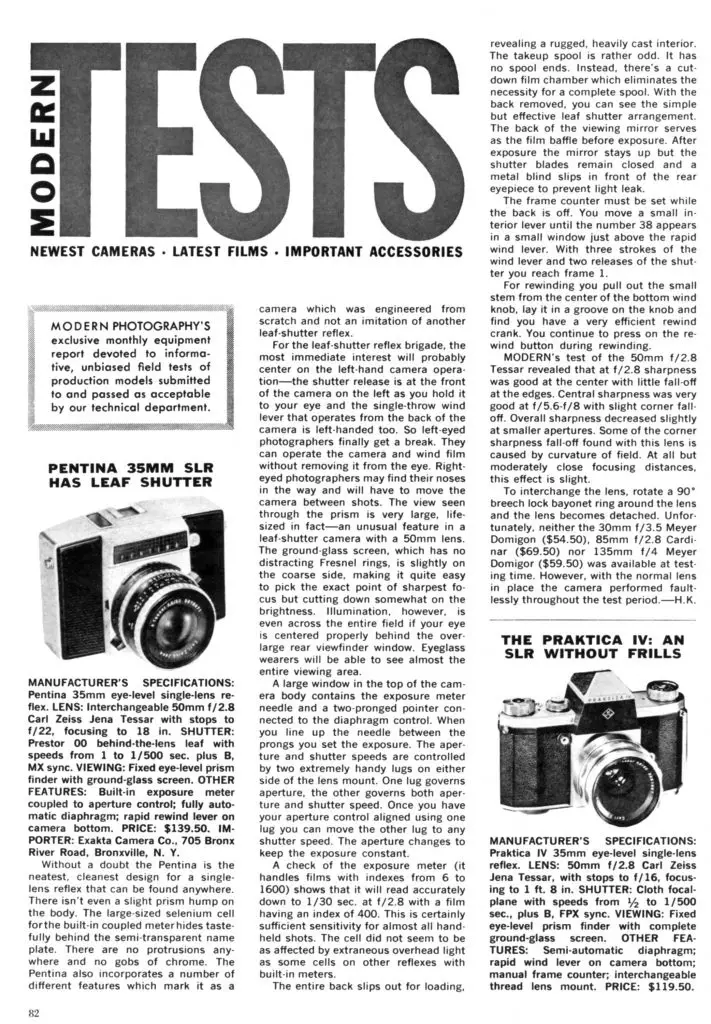










Good posting it brought back a few mwmories of cameras from my past! David
I’m surprise that more manufacturer didn’t offer a similarly styled interchangeable lens SLR camera during the early 1960s. If she had the disposable income, my mom would have instinctively chosen a camera like the Pentina over Minolta or Pentax of the same time period. My dad would have wanted the Contaflex just for the Zeiss Ikon name.
I use my old leaf-shutter SLR cameras gently. I fear that whatever lubricants were used nearly 60 years ago may be a bit gummy by now.
Andrew, you bring up a good question. I wonder how many “moms” and other people might have purchased the Pentina entirely on it’s looks! It certainly affected my decision, but only as a curiosity, not an every day camera. I guess the answer to that question is “not many” as the camera was not in production for very long.
Mike, you’re a lucky man, finding a working Pentina. A lefty camera, like the Exakta series – one of which, the VP Exakta SLR, predated the GOMZ Start in the marketplace by at least one year. Granted, the VP models use 127 film and the Start 35mm, but the first-to-market with a viable SLR honors belong to Ihagee.
I don’t know how lucky I am as the camera barely made it to the halfway point of it’s first roll before permanently dying! The camera still sits on my shelf dead and while I do enjoy looking at it, I likely won’t ever invest the money needed to get it repaired. At the end of the day, its just another 35mm SLR with a Tessar lens. I have enough Exaktas and Prakticas that use a lens of the same formula.
Interesting you mention the VP Exakta as that’s a camera I have access to and will likely one day review here!
The Pentina is such a “less is more” design that it wouldn’t look out of place on the set of Stanley Kubrick’s “2001: A Space Odyssey.” This potential East German gem reminds me of the Contaflex III and IV that I owned briefly in the 1980’s. (I was thinking of buying a 6X6 SLR, and the non-quick-return/”the picture just disappears” aspect was something to get used to, before the Bronica ETR-C of a bit later.)
The Zeiss Contaflexes never gave me any serious trouble, and aside from “tiny” to “extra large” filter sizes, worked as well as Ye Olde Nikkormat FTN. I had heard that 35mm leaf shutter SLRs were unreliable and expensive to repair if it broke, but mine never did.
As for the “chancy breech lock bayonet,” it didn’t seem to be a problem until a naive person turned the wrong ring on my Canon FP, but caught the lens before it “kissed concrete.” It’s too bad that your Pentina seized up completely, It does look as cool as the Nikkorex 35 of the same era.
I do love the design of the Pentina. It immediately stuck to me the first time I saw it and it still does today. Going through as many cameras as I have, I maintain a policy of primarily keeping cameras in my permanent collection that work. I don’t have the space or time for too many broken cameras. On occasion, I make exceptions and keep a broken camera if I like it enough and the Pentina is one of those exceptions. It’s just so sleek and cool looking!
I also don’t hate breech lock lenses as much as some people do, but I just feel that the supposed benefit of them is pretty much just marketing hype. I would be willing to bet that there have only been a handful of photographers in the history of photography that have swapped lenses on their SLRs enough time to file down the film plane to where there is a focusing error. Nikon Fs have been some of the most abused and heavily used cameras ever made, some being in regular every day use for decades, and I’ve never heard of anyone ever saying their camera has a focusing error due to this.
Cool Mike — I love unique looking and rare cameras like this — collectible or not. Thus is the downfall of my savings account! I have a Contaflex IV that I got for not too much which is in very good shape (the selenium meter is about dead, but it can be shot manually) — but I have had issues with the leaves on the shutter not returning completely every time despite “exercising” it a lot. Oh, the focus ring is incredibly stiff also — but it is a beautiful camera to look at! It came with a half-shot roll of TriX in it — not ancient — looked to be less than 10 years old based on the canister. So I finished the roll and sent it off. Half of my shots were ruined because of the slow return of the shutter, but it must have been working much better for the previous owner as all of the shots already on the roll came out fine (if a little fogged by age) — and yes, the clean crispness of the lens is there. Which makes me grumpy that I cannot toss it (gently!) into my vintage camera bag and take it out (well, after the lockdown!) to the park and shoot a roll or two! Stay Safe!!!
Dana, the Contaflex Super that I reviewed had a stiffness in the shutter that I was able to resolve with a flush of naphtha. Inside the film compartment of your camera, on the left (supply) side is a large round screw. Remove this screw to gain access to the mirror box. Leave this screw off and then remove the lens and squirt a steady stream of naphtha into the shutter with the camera facing down into a utility sink. Don’t be afraid to use a lot as you need to flush the old gunk out of the shutter.
Professional camera repairmen will tell you this is not the correct way to service the shutter on any camera, and they’re right, but if your aim is to experience your camera a couple of times and shoot a roll of film in it, it will work.
Once you’ve flushed it, let it air dry overnight with that screw off. Some debris might get on the reflex mirror, so use a Q-tip and stick it in that hole and gently wipe off the mirror to clean it. You might even have to reflush it a couple of times, letting it dry again overnight a couple of times. When it seems to be firing OK dry, put the screw back in the film compartment and try loading in some film!
This should work, and hopefully allow you to shoot some film in that wonderful camera!
Hi Mike. I thoroughly enjoyed this review and I do like a good mystery (i.e. the mythical first generation Pentina). Do you think you may have inadvertently solved the mystery? If the second generation Pentinas were the first ones produced starting in May 1963, how is there a magazine review from January 1962? Maybe there was just one generation of cameras starting in 1961 that had a production hiatus for some now unknown reason.
I have an original Pentina making its way across the Channel from France. It supposedly works. We shall see!
Your explanation could be correct, as this wouldn’t have been the first time, a camera’s model number was changed with no changes to the actual canera. The Fujicarex I and II, and Vokar and II are two good examples of this.